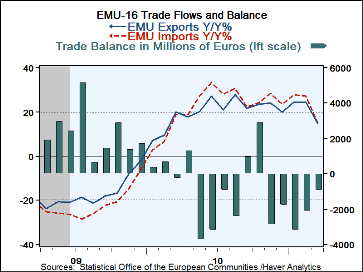 Global| May 16 2011
Global| May 16 2011Zone Trade Flows Show Mixed Signals But Stay Strong
Summary
The EMU trade picture is somewhat unclear as both exports and imports accelerate over shorter horizons from three-months to six-months to twelve-months but each flow also sees a decline in the progression of the Yr/Yr growth rate. One [...]
 The EMU trade picture is somewhat unclear as both exports and imports accelerate over shorter horizons from three-months to
six-months to twelve-months but each flow also sees a decline in the progression of the Yr/Yr growth rate. One year ago the
12-month growth rate for exports and imports was 20% and 19% respectively. In March export growth was running at 14.7% Yr/Yr
and import growth is at 15.2% Yr/Yr.
The EMU trade picture is somewhat unclear as both exports and imports accelerate over shorter horizons from three-months to
six-months to twelve-months but each flow also sees a decline in the progression of the Yr/Yr growth rate. One year ago the
12-month growth rate for exports and imports was 20% and 19% respectively. In March export growth was running at 14.7% Yr/Yr
and import growth is at 15.2% Yr/Yr.
Still the shorter term growth rates show acceleration and consistent acceleration. Of course, the short term growth rates are subject to more volatility and are therefore less reliable. But when the pattern across various short term segments is consistent, as it is this time showing a trend to increasingly stronger growth across horizons for both exports and for imports, the message is unclear when the short term and longer term patterns are juxtaposed.
For both exports and for imports the pattern of strength is in gear for sequential growth rates as the component themes over shorter horizons for both export and import detail sends the same conflicted signal as across the main commodity groups. That is that components are accelerating across shorter horizons but still show decelerations in the compared Yr/Yr pace.
On balance it seems that whatever weakening may be in store for EMU exports, it is not very pronounced. Short terms flows have been on the rebound and are gaining strength even though their Year-over-year metrics are lower. We have seen other information suggesting that MFG in the Zone has eased somewhat from its early recovery pace, but it is too soon to the draw the same conclusion about export and import flows in the zone.
Export growth rates over three-months are in the 30% to 40% range when annualized; this is exceptionally strong. For imports the growth rates range from a low of 14.3% for food and drinks to a high of 41% for raw materials where surging oil prices are leading the 3-month growth rates to balloon. Despite such distortions, imports too are relatively strong across categories. EMU trade does not show really show much sign of slowing.
| Euro-Area Trade Trends For Goods | ||||||
|---|---|---|---|---|---|---|
| M/M% | % SAAR | |||||
| Mar-11 | Feb-11 | 3M | 6M | 12M | 12M Ago | |
| Balance* | € (935) | € (2,052) | € 964 | € (1,299) | € 1,822 | € (4,496) |
| EXPORTS | ||||||
| All Exp | 1.1% | 1.6% | 30.9% | 17.6% | 14.7% | 20.0% |
| Food and Drinks | 5.2% | 2.7% | 42.9% | 24.8% | 17.1% | 13.8% |
| Raw materials | 0.2% | -0.3% | 38.4% | 26.6% | 18.7% | 32.3% |
| Other | 0.8% | 1.6% | 29.8% | 16.8% | 14.4% | 20.2% |
| MFG | 0.6% | 3.0% | 31.5% | 13.4% | 12.0% | 19.1% |
| IMPORTS | ||||||
| All IMP | 0.3% | 0.8% | 27.6% | 21.0% | 15.2% | 19.0% |
| Food and Drinks | 0.4% | 0.3% | 14.3% | 16.9% | 18.8% | -0.3% |
| Raw materials | 1.9% | 3.3% | 41.0% | 37.4% | 30.3% | 46.6% |
| Other | 0.2% | 0.7% | 27.9% | 20.4% | 14.2% | 19.3% |
| MFG | 0.1% | 2.1% | 23.9% | 12.1% | 11.8% | 17.8% |
| *Eur mlns; Mo or period average (SA, WDA) | ||||||
Robert Brusca
AuthorMore in Author Profile »Robert A. Brusca is Chief Economist of Fact and Opinion Economics, a consulting firm he founded in Manhattan. He has been an economist on Wall Street for over 25 years. He has visited central banking and large institutional clients in over 30 countries in his career as an economist. Mr. Brusca was a Divisional Research Chief at the Federal Reserve Bank of NY (Chief of the International Financial markets Division), a Fed Watcher at Irving Trust and Chief Economist at Nikko Securities International. He is widely quoted and appears in various media. Mr. Brusca holds an MA and Ph.D. in economics from Michigan State University and a BA in Economics from the University of Michigan. His research pursues his strong interests in non aligned policy economics as well as international economics. FAO Economics’ research targets investors to assist them in making better investment decisions in stocks, bonds and in a variety of international assets. The company does not manage money and has no conflicts in giving economic advice.






